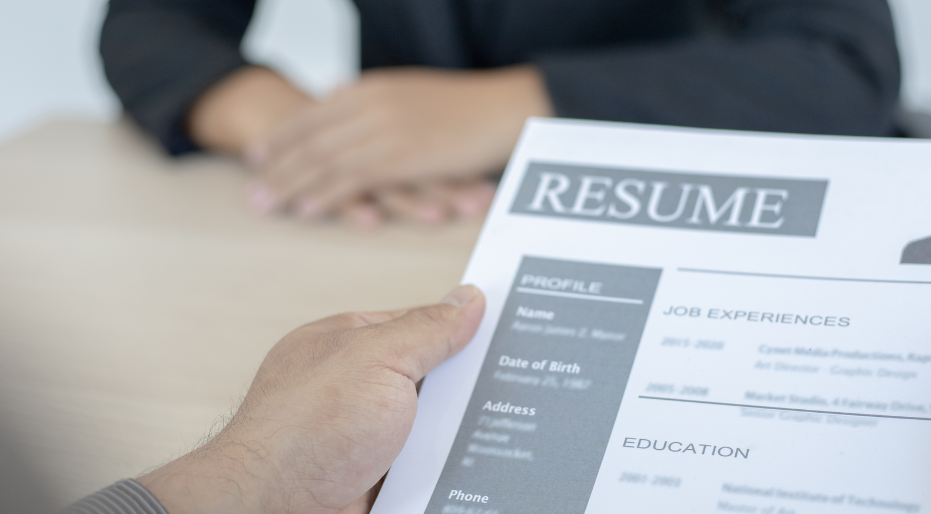Refusing to employ disabled people
This blog was first published by El Gibbs on 5 February, 2023 at https://www.bluntshovels.au/
This writing is thanks to supporters of https://www.bluntshovels.au/. Sign up and subscribe on the site.

An image of someone holding their resume, handing it to another pair of hands across the table.
Over the last few months, a range of employers have talked about how hard it is to find staff, but what they are really saying is that they won’t hire disabled people.
The Australian Bureau of Statistics (ABS) recently reported that, while they have dropped a bit, “job vacancies were 94.9% higher than they were in February 2020, prior to the start of the pandemic. The ongoing high level of vacancies reflected the continuing labour shortages in some industries.”
Employers have been talking about this in the media, with their peak bodies, such as the Australian Industry Group saying ‘Skills shortages. Understaffed. Turnover and churn. Couldn’t recruit. “I just need more people!”’ The Business Council of Australia agrees, saying ‘Businesses crying out for almost half a million workers to fill roles and keep their doors open, more than double pre-pandemic levels.’
Cafes say they are going to have to close, as do restaurants. Staff shortages are being reported across public and private sectors, such as swimming pools, aged care, fire fighting, healthcare, schools, hospitality, crossing guards, childcare, and in disability support.
In the United States, who have had the same kinds of staff shortages, employers have responded by hiring disabled people.
The unemployment rate of disabled people has fallen, with changes to workplace flexibility due to the pandemic, along with pandemic related staff shortages, leading to more disabled people being in work.
There has also been a reduction in applications for disability benefits. This isn’t necessarily causative, as the US disability application process is notoriously difficult, and many folks newly disabled by Long COVID may not be showing up in these figures. But both figures show that employers, faced with staff shortages, have responded by hiring more disabled people.
Is this trend of more disabled people getting work being seen in Australia? It’s not as easy to find out, as we don’t publish the same kind of employment figures as the US does. The regular ABS employment data doesn’t show how many disabled people are getting jobs.
Time to look somewhere else. One data set that could be revealing is the DSS Demographic data, showing the number of people receiving different kinds of income support payments. This data is released quarterly, and lists how many people on which payment, how long they have been on that payment, and if they are on Jobseeker, how many people have a ‘partial capacity to work’ which indicates the numbers of disabled and sick people who are unemployed.
The other useful indicator from income support data is the number of people who get the Disability Support Pension (DSP), the closest equivalent to the US disability benefits.
So what is happening with these two data measures?
I analysed the most recent year of figures, from September 2021 to September 2022. They showed that the percentage of folks getting Jobseeker, who have a partial capacity to work, is increasing, and there are more people getting the DSP.
This clearly shows that there is not an increase in disabled people getting work, and potentially, the employment situation for disabled people is actually getting worse.


So, after a year of employers complaining that they can’t find staff, and staff shortages being widely reported, the number of disabled people on income support, so out of work, is actually increasing. Discrimination against us in employment is widespread and rampant, with so many of us refused access to a job, even when there are acute staff shortages.
This shows very clearly that there is a much bigger problem with employment of disabled people than any number of pilots, or strategies, or tinkering at the edges can fix. This also shows that the current disability employment system isn’t working, and can’t be allowed to continue in its current form.
The 2016 Willing to Work inquiry from the Human Rights Commission made a number of detailed recommendations, very similar to every single other inquiry or consultation since. And yes, governments continue to throw money at the private employment system when they have clearly demonstrated that they don’t work. Governments also refuse to act to address the discrimination we experience in getting and keeping a job.
It is past time to put disabled people in charge of fixing employment discrimination against disabled people, and to get serious about ending discrimination against us.
Latest Ideas
- Who Benefits? Unpacking International Day of People with Disability
- “The Assembly” misses the mark: here’s how I’d get it back on track
- No place like home: the fight for accessible housing in Australia
- Be afraid, wheelchairs on a plane
- Blazing the Trail – how CPActive is transforming NSW Public Sector Employment for People with Disabilities
Send us your idea
Send an outline to us by email at: info@disabilitydialogue.com.au. Please attach any supporting documents or images. Thanks for your contribution – we will contact you via email.

